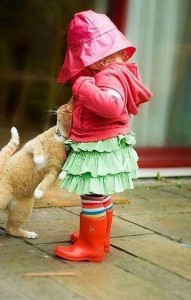In recent weeks I have received lots of questions from young parents about managing the roller coaster of emotions that are so common with toddlers and preschoolers. Hope the information shared is helpful…
The years from 2 to 5 are exciting and fun. By age two, children have
- learned the basic skills of walking and talking
- gained a sense of personal identity
- developed a greater understanding of others’ needs and feelings
- can think in ways that are more complex, better able to consider others’ wishes and act in positive ways to help them
- developed greater self-control
- the ability to relate to people and the world in more complex ways
Developmentally, this is a very busy age group, filled with lots of changes and adjustments as a result of their rapid growth and awareness of their environment. I think that the emotional components can be particularly unpredictable and challenging. But even though this stage can be difficult for parents, caregivers, and teachers, it is such an important and amazing aspect of a child’s development! Hang in there!
Physical Development
Between ages 2 – 5
- growth is slower than before, but still rapid — from about 34 inches and 29 pounds to about 42 inches and 42-45 pounds
- brains are active and primed for learning — brain development helps the child control voluntary movements and increases alertness and memory
Intellectual Development
Greater motor coordination allows children of this age to interact with objects in the environment in more complex ways. This is related to
- increased attention span and memory
- thinking that is more complex
- greater understanding of people
- an understanding that others’ desires determine their actions
- the ability to see that others’ thoughts determine both feelings and actions
Language Development
Children progress
- from having about 50 words at nineteen months to having 10,000 by age six — in the first grade they learn about 5.5 words per day (Bloom, 1998)
- to using longer sentences
Language development is influenced by
- parents
- child’s ability to initiate conversations and learn not only language from parents’ responses but also social rules, others’ expectations, and general guidelines for solving social problems (Bloom, 1998)
Emotional Development
Understanding and complexity of feelings grows by leaps and bounds at this stage.
Preschoolers are becoming increasingly accurate in understanding the connections between feelings and the events and social interactions that produce them. At first they believe that feelings are temporary, but by the end of the preschool period, children typically recognize that feelings can persist and are influenced by what one thinks.
Children can accurately identify what triggers emotions, especially when there is a social cause for the feelings.
Preschoolers’ most common form of emotional upset is crying.
Parents’ usual response to distress is not to comfort but to give the child a practical, problem-solving response so that the child can deal with the situation.
By this age children can not only express feelings, but can hide them as well.
Temperament influences their emotional reactions, the ease with which they can control them, and the forms in which they express these feelings.
Children who are emotionally intense and have heightened negative affect are more poorly controlled and less able to regulate the expression of their emotions. When angry or upset, they act out, often in aggressive ways. This behavior compounds their problem, because it generally does not lead to positive resolutions to the upsetting situation.
Children who do not become overly aroused emotionally regulate their feelings, talk over the situation, and find more adaptive solutions to the upset.
Parents who encourage children to express their feelings of sadness and distress and teach them ways to deal with these feelings appropriately help children to express themselves and find solutions to upsetting events.
Common emotions expressed by young children include anger, fear, and empathy.
Anger
Children continue to battle with parents about daily routines. Peers can become a source of frustration as well during these years. (“He took my doll!” “She gets to stay up later than I do!” “Why can’t I have one, too?”)
The most competent children handle anger in direct ways that reduce further conflict and maintain positive relationships. Boys typically express their feelings and take no action; girls typically assert themselves to obtain their wishes (Eisenberg, 1994).
Three emotional styles of responding to anger were identified by Cummings (1987).
- concerned emotional responders (46%) – show negative feelings of upset and later report sadness
- unresponsive responders (15%) – show now emotional reaction
- ambivalent responders (35%) – show both positive and negative feelings
Ambivalent responders are more likely to become physically aggressive in play following and anger episode. Learning to handle ambivalent feelings may lead to a decrease in aggressive responses.
Fear
Fears are a natural part of life. In the early years, fears of noise, loss of support, and strangers are most common. These anxieties usually fade. Preschoolers often experience fears of animals, the dark, harm from imaginary creatures, and natural disasters. Anxiety and fear in response to unfamiliar people and strange situations may result from temperamental qualities.
Some children become extremely excited when faced with something new and different. Such excitability is identified in infancy and manifests in inhibited, avoidant behavior that can persist throughout the early years (Broberg, Lamb, Hwong, 1990). Inhibited children
- play less freely at home and in care settings
- have difficulty taking turns
- have difficulty engaging in fantasy play
By not rewarding over reactivity and providing structure, parents can help children overcome these reactions.
Fears help to keep children safe, but intense fears can prevent a child from exploring the world and interacting with other people. Preschool boys who experienced intense fears of bodily harm were, as adults anxious about sexuality, uninvolved with traditional masculine activities, and concerned with intellectual performance (Kagan & Moss, 1962).
Empathy
Children’s ability to respond sensitively to others’ needs increases as they grow. Young children are often quite nurturing toward others who are vulnerable or in distress.
Sharing with and giving to friends occurs most frequently in an atmosphere of comfort and optimism.
Characteristics of empathic children have parents who
- are warm, caring individuals concerned with the well-being of others
- expect children to control aggression, and show disappointment when they do show aggression
- teach children how to do what is expected
- model kindness
- maintain high standards
Development of the Self
Most preschoolers are optimistic and confident. They believe that when they want something, they will be able to achieve it, and they ignore any failures along the way.
Most children continue to focus on their positive qualities and see themselves as “all good.” Children who have experienced abuse, however, are more likely to consider themselves as bad.
Development of Self-Regulation
Most preschoolers know the rules and can follow them, much of the time without reminders. They are better able to use verbal means of refusing and negotiating compromises. Parents who have used verbal requests to induce compliance and verbal feedback to modify inappropriate behavior have the most cooperative children at age five.
Defiance occurs most frequently when parents use high-power strategies such as commands, criticisms, threats, and physical punishments to control children’s behavior (Brooks, p.286).
Provide suggestions and guidance in the form of
- explaining
- persuading
- directing
- verbally assisting the child to do what is wanted
- giving feedback about difficulties
all increase compliance.
Positive feelings increase children’s compliance.
Reference:
Adapted from Brooks, Jane. B. (2008). The process of parenting, 7th edition. Boston, McGraw-Hill.

